Study on the Correlation between Ecological Service Value and Ecological Risk of Typical Mountain-Oasis-Desert Ecosystems: A Case Study of Aksu City in Northwest China
Abstract
:1. Introduction
2. Materials and Methods
2.1. Study Area
2.2. Data Sources and Processing
2.2.1. Data Sources
2.2.2. Data Processing
2.3. Method of Analysis
2.3.1. Models for Estimating the Value of Ecological Services
2.3.2. Landscape Ecological Risk Index Accounting Model
2.3.3. Bivariate Autocorrelation Model
3. Results and Analysis
3.1. Characteristics of Changes in Land Use Types
3.2. Spatial and Temporal Characteristics of the Value of Ecological Services
3.2.1. Calculation of the Value of Ecosystem Services
3.2.2. Spatial Distribution of the Value of Ecological Services
3.3. Spatial Differentiation Characteristics of Landscape Ecological Risk
3.4. Analysis of the Correlation between the Value of Ecosystem Services and Ecological Risk
3.4.1. Quantitative Correlation
3.4.2. Temporal Correlation
3.4.3. Spatial Correlation
4. Discussion
- (1)
- The areas along the Aksu River and the surrounding areas are high value-high risk agglomeration areas, and in the whole mountain-oasis-desert ecosystem, the three land use types contributing to high ecological service value, namely woodland, grassland, and waterbody, account for less, so that the river and its cultivated land become the main ecological service value contributors. However, since Aksu City is the main grain-producing area in the southern border region and bears a large amount of the red line of cropland, the region has become a major ecological service contributor due to the focus on promoting green agriculture [54], leading to comprehensive land improvements being carried out in the whole region promoting the optimization of farmland ecosystems [55] and highlighting the value of the provisioning services in cropland ecosystems [56], and at the same time, guarding against the sources of risk [57], establishing a risk early-warning mechanism, preventing sudden natural disasters [58], and reinforcing the barriers of ecological security patterns [59].
- (2)
- Part of the high value-high risk area is intersected with the northern mountainous Gobi, which is a sandy and windy area where land fertility is depleting [60], the quality of the soil environment is declining, and there are many desertification and soil salinization phenomena; therefore, soil erosion should be controlled as much as possible in the area [61], so as to achieve the protection and rational use of soil and water resources and realize the sustainable development of the economy and society [62]. There is also a need to prevent the expansion of desertification [63], and the region’s proximity to oases and its windy weather make it susceptible to sand and dust storms, which can have an impact on the lives of townspeople.
- (3)
- Insignificant and low value-low risk zone: The region of concern exhibits low-value ecosystem services and a low level of ecological risk. It is the largest area within the study area and is primarily composed of a desert ecosystem. Furthermore, it is identified as an area in need of mainly ecological improvement. In order to promote local socio-economic development, it is imperative to effectively control and reduce desertification in this region. It is crucial to protect this sort of region and implement effective methods to combat desertification. This can be achieved by government support in developing vegetation in sandy areas and implementing eco-industrial projects to manage desertification [57].
- (4)
- The high value-low risk aggregation area has significant ecological service value per unit area and a low ecological risk rating, which makes it a crucial ecological safety zone for the study area. The region is predominantly characterized by rivers and grasslands, which play a crucial role in providing vital ecological services. The ecological service function of the region can be preserved and enhanced while mitigating ecological risks by establishing protection zones [64] and implementing other measures.
5. Conclusions
- (1)
- The most prevalent land use type in Aksu City is bare land, which forms the primary component of the characteristic mountain-oasis-desert ecological system. The total area of bare land in Aksu City exceeds 81% of the city’s total land area. Between 2000 and 2020, the city experienced a land use transfer of 459.83 km2.
- (2)
- From 2000 to 2020, the general value of ecosystem services in Aksu City exhibited a consistent decline, starting at CNY 50.65 × 108 and reaching CNY 47.24 × 108. This decline was relatively stable, with an average annual decline rate of 0.34%.
- (3)
- The ERI index of Aksu City during the designated study period exhibited a fluctuating upward trend, which indicated that the ecological security situation has a tendency to deteriorate. The study area exhibited a continuous and concentrated distribution of higher risk and high-risk locations, a random distribution of low-risk and medium-risk areas, and a piecemeal distribution of lower risk areas.
- (4)
- There exists a positive spatial correlation between the ecological service value (ESV) and ecological risk index (ERI) in Aksu City. Additionally, there was an observed in-crease in the area of high-value and high-risk zones between 2000 and 2020. These zones were primarily concentrated in urban construction land and cultivated land within the study area.
Author Contributions
Funding
Institutional Review Board Statement
Informed Consent Statement
Data Availability Statement
Acknowledgments
Conflicts of Interest
References
- Costanza, R.; d’Arge, R.; De Groot, R.; Farber, S.; Grasso, M.; Hannon, B.; Limburg, K.; Naeem, S.; O’Neill, R.V.; Paruelo, J.; et al. The Value of the World’s Ecosystem Services and Natural Capital. Nature 1997, 387, 253–260. [Google Scholar] [CrossRef]
- European Commission; Joint Research Centre; Institute for Environment and Sustainability. Mapping and Assessment of Ecosystems and Their Services: Trends in Ecosystems and Ecosystem Services in the European Union between 2000 and 2010; Publications Office: Luxembourg, 2015. [Google Scholar]
- Reid, W.V. Millennium Ecosystem Assessment: Ecosystems and Human Well-Being; 2005; ISBN 978-1-59726-040-4. Available online: https://www.wri.org/research/millennium-ecosystem-assessment-ecosystems-and-human-well-being (accessed on 6 April 2024).
- Xia, S.; Liu, Y.; Yu, X.; Fu, B. Challenges in Coupling LTER with Environmental Assessments: An Insight from Potential and Reality of the Chinese Ecological Research Network in Servicing Environment Assessments. Sci. Total Environ. 2018, 633, 1302–1313. [Google Scholar] [CrossRef] [PubMed]
- Jiang, W.; Lü, Y.; Liu, Y.; Gao, W. Ecosystem Service Value of the Qinghai-Tibet Plateau Significantly Increased during 25 Years. Ecosyst. Serv. 2020, 44, 101146. [Google Scholar] [CrossRef]
- Fu, B.; Li, Y.; Wang, Y.; Zhang, B.; Yin, S.; Zhu, H.; Xing, Z. Evaluation of Ecosystem Service Value of Riparian Zone Using Land Use Data from 1986 to 2012. Ecol. Indic. 2016, 69, 873–881. [Google Scholar] [CrossRef]
- Zang, Z.; Zou, X.; Zuo, P.; Song, Q.; Wang, C.; Wang, J. Impact of Landscape Patterns on Ecological Vulnerability and Ecosystem Service Values: An Empirical Analysis of Yancheng Nature Reserve in China. Ecol. Indic. 2017, 72, 142–152. [Google Scholar] [CrossRef]
- Jacobides, M.G.; Cennamo, C.; Gawer, A. Towards a Theory of Ecosystems. Strateg. Manag. J. 2018, 39, 2255–2276. [Google Scholar] [CrossRef]
- Granstrand, O.; Holgersson, M. Innovation Ecosystems: A Conceptual Review and a New Definition. Technovation 2020, 90–91, 102098. [Google Scholar] [CrossRef]
- Sun, D.; Zhang, J.; Zhu, C.; Hu, Y.; Zhou, L. An Assessment of China’s Ecological Environment Quality Change and Its Spatial Variation. Acta Geograph. Sin. 2012, 67, 1599–1610. [Google Scholar] [CrossRef]
- Jia, Y.; Tang, X.; Liu, W. Spatial–Temporal Evolution and Correlation Analysis of Ecosystem Service Value and Landscape Ecological Risk in Wuhu City. Sustainability 2020, 12, 2803. [Google Scholar] [CrossRef]
- Li, J.; Sun, W.; Li, M.; Meng, L. Coupling Coordination Degree of Production, Living and Ecological Spaces and Its Influencing Factors in the Yellow River Basin. J. Clean. Prod. 2021, 298, 126803. [Google Scholar] [CrossRef]
- Xu, K.; Wang, J.; Wang, J.; Wang, X.; Chi, Y.; Zhang, X. Environmental Function Zoning for Spatially Differentiated Environmental Policies in China. J. Environ. Manag. 2020, 255, 109485. [Google Scholar] [CrossRef] [PubMed]
- Gao, X.; Shen, J.; He, W.; Zhao, X.; Li, Z.; Hu, W.; Wang, J.; Ren, Y.; Zhang, X. Spatial-Temporal Analysis of Ecosystem Services Value and Research on Ecological Compensation in Taihu Lake Basin of Jiangsu Province in China from 2005 to 2018. J. Clean. Prod. 2021, 317, 128241. [Google Scholar] [CrossRef]
- Darvill, R.; Lindo, Z. The Inclusion of Stakeholders and Cultural Ecosystem Services in Land Management Trade-off Decisions Using an Ecosystem Services Approach. Landsc. Ecol. 2016, 31, 533–545. [Google Scholar] [CrossRef]
- Lautenbach, S.; Kugel, C.; Lausch, A.; Seppelt, R. Analysis of Historic Changes in Regional Ecosystem Service Provisioning Using Land Use Data. Ecol. Indic. 2011, 11, 676–687. [Google Scholar] [CrossRef]
- Daily, G.C.; Söderqvist, T.; Aniyar, S.; Arrow, K.; Dasgupta, P.; Ehrlich, P.R.; Folke, C.; Jansson, A.; Jansson, B.-O.; Kautsky, N.; et al. The Value of Nature and the Nature of Value. Science 2000, 289, 395–396. [Google Scholar] [CrossRef] [PubMed]
- Xie, G.; Lu, C.; Leng, Y.; Zheng, D.; Li, S. Ecological assets valuation of the Tibetan Plateau. J. Nat. Resour. 2003, 18, 189–196. [Google Scholar] [CrossRef]
- Kang, N.; Hou, L.; Huang, J.; Liu, H. Ecosystem Services Valuation in China: A Meta-Analysis. Sci. Total Environ. 2022, 809, 151122. [Google Scholar] [CrossRef] [PubMed]
- Xie, G.; Zhang, C.; Zhang, L.; Chen, W.; Li, S. Improvement of the Evaluation Method for Ecosystem Service Value Based on Per Unit Area. J. Nat. Resour. 2015, 30, 1243–1254. [Google Scholar] [CrossRef]
- Xie, G.; Xiao, Y.; Zhen, L.; Lu, C. Study on ecosystem services value of food production in China. Chin. J. Eco-Agric. 2005, 13, 10–13. [Google Scholar]
- Xie, G.; Zhen, L.; Lu, C.; Xiao, Y.; Chen, C. Expert Knowledge Based Valuation Method of Ecosystem Services in China. J. Nat. Resour. 2008, 23, 911–919. [Google Scholar] [CrossRef]
- Piet, G.J.; Knights, A.M.; Jongbloed, R.H.; Tamis, J.E.; de Vries, P.; Robinson, L.A. Ecological Risk Assessments to Guide Decision-Making: Methodology Matters. Environ. Sci. Policy 2017, 68, 1–9. [Google Scholar] [CrossRef]
- Perrodin, Y.; Boillot, C.; Angerville, R.; Donguy, G.; Emmanuel, E. Ecological Risk Assessment of Urban and Industrial Systems: A Review. Sci. Total Environ. 2011, 409, 5162–5176. [Google Scholar] [CrossRef] [PubMed]
- Li, J.; Gao, M. Spatiotemporal evolution and correlation analysis of ecosystem service values and ecological risk in Binzhou. Acta Ecol. Sin. 2019, 39, 7815–7827. [Google Scholar] [CrossRef]
- Zhang, J.; Qin, G.; Cheng, S.; Wen, Y. Spatiotemporal Changes and Correlation Between Landscape Ecological Risk and Ecological Service Value in Hanjiang Eco-economic Belt. Bull. Soiland Water Conserv. 2023, 43, 294–306. [Google Scholar] [CrossRef]
- Kang, P.; Chen, W.; Wang, M. Advances in ecosystem service based ecological risk assessment. Acta Ecol. Sin. 2016, 36, 1192–1203. [Google Scholar] [CrossRef]
- Mamat, A.; Wang, J.; Ma, Y. Impacts of Land-Use Change on Ecosystem Service Value of Mountain–Oasis–Desert Ecosystem: A Case Study of Kaidu–Kongque River Basin, Northwest China. Sustainability 2020, 13, 140. [Google Scholar] [CrossRef]
- Qiao, B.; Cao, X.; Sun, W. Ecological Zoning Identification and Optimization Strategies Based on Ecosystem Service Value and Landscape Ecological Risk: Taking Qinghai Area of Qilian Mountain National Park as an Example. Acta Ecol. Sin. 2023, 43, 986–1004. [Google Scholar] [CrossRef]
- ICS:07.040; Current Land Use Classification. Standardization Administration of China (SAC): Beijing, China, 2017.
- Oliver, M.A.; Webster, R. Kriging: A Method of Interpolation for Geographical Information Systems. Int. J. Geogr. Inf. Syst. 1990, 4, 313–332. [Google Scholar] [CrossRef]
- Xiao, J.; Qiao, B.; Chen, H.; Shi, F.; Cao, X.; Zhu, C. Land use change and evolution of ecosystem service value in Maduo County of source region of the Yellow River. Acta Ecol. Sin. 2020, 40, 510–521. [Google Scholar] [CrossRef]
- Wang, Y.; Dai, E.; Yin, L.; Ma, L. Land Use/Land Cover Change and the Effects on Ecosystem Services in the Hengduan Mountain Region, China. Ecosyst. Serv. 2018, 34, 55–67. [Google Scholar] [CrossRef]
- Gao, B.; Li, C.; Wu, M.; Zheng, K.; Wu, Y. Landscape ecological risk assessment and influencing factors in ecological conservation area in Sichuan-Yunnan provinces, China. Chin. J. Appl. Ecol. 2021, 32, 1603–1613. [Google Scholar] [CrossRef] [PubMed]
- Xie, H.; Wang, P.; Huang, H. Ecological Risk Assessment of Land Use Change in the Poyang Lake Eco-Economic Zone, China. Int. J. Environ. Res. Public Health 2013, 10, 328–346. [Google Scholar] [CrossRef] [PubMed]
- Liu, Y.; Hou, X.; Li, X.; Song, B.; Wang, C. Assessing and Predicting Changes in Ecosystem Service Values Based on Land Use/Cover Change in the Bohai Rim Coastal Zone. Ecol. Indic. 2020, 111, 106004. [Google Scholar] [CrossRef]
- Xiao, R.; Lin, M.; Fei, X.; Li, Y.; Zhang, Z.; Meng, Q. Exploring the Interactive Coercing Relationship between Urbanization and Ecosystem Service Value in the Shanghai–Hangzhou Bay Metropolitan Region. J. Clean. Prod. 2020, 253, 119803. [Google Scholar] [CrossRef]
- Zhu, R.; Chen, S. Spatial relationship between landscape ecological risk and ecosystem service value in Fujian Province, China during 1980–2020. Chin. J. Appl. Ecol. 2022, 33, 1599–1607. [Google Scholar] [CrossRef] [PubMed]
- Ren, H.; Shang, Y.; Zhang, S. Measuring the Spatiotemporal Variations of Vegetation Net Primary Productivity in Inner Mongolia Using Spatial Autocorrelation. Ecol. Indic. 2020, 112, 106108. [Google Scholar] [CrossRef]
- Zhang, Y.; Rashid, A.; Guo, S.; Jing, Y.; Zeng, Q.; Li, Y.; Adyari, B.; Yang, J.; Tang, L.; Yu, C.-P.; et al. Spatial Autocorrelation and Temporal Variation of Contaminants of Emerging Concern in a Typical Urbanizing River. Water Res. 2022, 212, 118120. [Google Scholar] [CrossRef] [PubMed]
- Wang, T.; Zhou, D.; Shen, X.; Fan, G.; Zhang, H. Koppen’s climate classification map for China. J. Meteorol. Sci. 2020, 40, 752–760. [Google Scholar] [CrossRef]
- Makanda, K.; Nzama, S.; Kanyerere, T. Assessing the Role of Water Resources Protection Practice for Sustainable Water Resources Management: A Review. Water 2022, 14, 3153. [Google Scholar] [CrossRef]
- Liang, X.; Jin, X.; Han, B.; Sun, R.; Xu, W.; Li, H.; He, J.; Li, J. China’s Food Security Situation and Key Questions in the New Era: A Perspective of Farmland Protection. J. Geogr. Sci. 2022, 32, 1001–1019. [Google Scholar] [CrossRef]
- Hou, L.; Wu, F.; Xie, X. The Spatial Characteristics and Relationships between Landscape Pattern and Ecosystem Service Value along an Urban-Rural Gradient in Xi’an City, China. Ecol. Indic. 2020, 108, 105720. [Google Scholar] [CrossRef]
- Li, L.; Huang, X.; Wu, D.; Wang, Z.; Yang, H. Optimization of Ecological Security Patterns Considering Both Natural and Social Disturbances in China’s Largest Urban Agglomeration. Ecol. Eng. 2022, 180, 106647. [Google Scholar] [CrossRef]
- Cao, Y.; Jiang, Y.; Feng, L.; Shi, G.; He, H.; Yang, J. Identification of Territorial Spatial Pattern Conflicts in Aksu River Basin, China, from 1990 to 2020. Sustainability 2022, 14, 14941. [Google Scholar] [CrossRef]
- Tian, Y. Cropland-Grassland Use Conversions in the Agro-Pastoral Areas of the Tibetan Plateau: Spatiotemporal Pattern and Driving Mechanisms. Ecol. Indic. 2023, 146, 109819. [Google Scholar] [CrossRef]
- Kang, P.; Chen, W.; Hou, Y.; Li, Y. Linking Ecosystem Services and Ecosystem Health to Ecological Risk Assessment: A Case Study of the Beijing-Tianjin-Hebei Urban Agglomeration. Sci. Total Environ. 2018, 636, 1442–1454. [Google Scholar] [CrossRef]
- Xu, X.; Yang, G.; Tan, Y.; Zhuang, Q.; Li, H.; Wan, R.; Su, W.; Zhang, J. Ecological Risk Assessment of Ecosystem Services in the Taihu Lake Basin of China from 1985 to 2020. Sci. Total Environ. 2016, 554–555, 7–16. [Google Scholar] [CrossRef] [PubMed]
- Xing, L.; Hu, M.; Wang, Y. Integrating Ecosystem Services Value and Uncertainty into Regional Ecological Risk Assessment: A Case Study of Hubei Province, Central China. Sci. Total Environ. 2020, 740, 140126. [Google Scholar] [CrossRef] [PubMed]
- Du, L.; Gong, F.; Zeng, Y.; Ma, L.; Qiao, C.; Wu, H. Carbon Use Efficiency of Terrestrial Ecosystems in Desert/Grassland Biome Transition Zone: A Case in Ningxia Province, Northwest China. Ecol. Indic. 2021, 120, 106971. [Google Scholar] [CrossRef]
- Xu, Z.; Peng, J.; Dong, J.; Liu, Y.; Liu, Q.; Lyu, D.; Qiao, R.; Zhang, Z. Spatial Correlation between the Changes of Ecosystem Service Supply and Demand: An Ecological Zoning Approach. Landsc. Urban Plan. 2022, 217, 104258. [Google Scholar] [CrossRef]
- Pan, N.; Du, Q.; Guan, Q.; Tan, Z.; Sun, Y.; Wang, Q. Ecological Security Assessment and Pattern Construction in Arid and Semi-Arid Areas: A Case Study of the Hexi Region, NW China. Ecol. Indic. 2022, 138, 108797. [Google Scholar] [CrossRef]
- Liu, Y.; Sun, D.; Wang, H.; Wang, X.; Yu, G.; Zhao, X. An Evaluation of China’s Agricultural Green Production: 1978–2017. J. Clean. Prod. 2020, 243, 118483. [Google Scholar] [CrossRef]
- Bethwell, C.; Burkhard, B.; Daedlow, K.; Sattler, C.; Reckling, M.; Zander, P. Towards an Enhanced Indication of Provisioning Ecosystem Services in Agro-Ecosystems. Environ. Monit. Assess. 2021, 193, 269. [Google Scholar] [CrossRef] [PubMed]
- Xiao, Y.; Li, Y.; Tang, X.; Huang, H.; Wang, R. Assessing Spatial–Temporal Evolution and Key Factors of Urban Livability in Arid Zone: The Case Study of the Loess Plateau, China. Ecol. Indic. 2022, 140, 108995. [Google Scholar] [CrossRef]
- Hu, B.; Xie, M.; He, R.; Shi, Z.; Zhou, Y.; Ni, H.; Li, H. Spatio-Temporal Evolution of Cropland Ecosystem Services Value and Its Spatially Varying Dominate over the Past Two Decades: A Case Study in Jiangxi Province in Southern China. J. Clean. Prod. 2023, 427, 139228. [Google Scholar] [CrossRef]
- Da Silva, G.F.P.; Pegetti, A.L.; Piacesi, M.T.; Belderrain, M.C.N.; Bergiante, N.C.R. Dynamic Modeling of an Early Warning System for Natural Disasters. Syst. Res. Behav. Sci. 2020, 37, 292–314. [Google Scholar] [CrossRef]
- Gao, J.; Du, F.; Zuo, L.; Jiang, Y. Integrating Ecosystem Services and Rocky Desertification into Identification of Karst Ecological Security Pattern. Landsc. Ecol. 2021, 36, 2113–2133. [Google Scholar] [CrossRef]
- Mosier, S.; Córdova, S.C.; Robertson, G.P. Restoring Soil Fertility on Degraded Lands to Meet Food, Fuel, and Climate Security Needs via Perennialization. Front. Sustain. Food Syst. 2021, 5, 706142. [Google Scholar] [CrossRef]
- Chen, J.; Li, Z.; Xiao, H.; Ning, K.; Tang, C. Effects of Land Use and Land Cover on Soil Erosion Control in Southern China: Implications from a Systematic Quantitative Review. J. Environ. Manag. 2021, 282, 111924. [Google Scholar] [CrossRef]
- Li, Y.; Zhang, X.; Zhi, C.; Liu, Z.; Lu, Z.; Liu, Y. Towards the Progress of Ecological Restoration and Economic Development in China’s Loess Plateau and Strategy for More Sustainable Development. Sci. Total Environ. 2021, 756, 143676. [Google Scholar] [CrossRef]
- Martínez-Valderrama, J.; Ibáñez, J.; Del Barrio, G.; Sanjuán, M.E.; Alcalá, F.J.; Martínez-Vicente, S.; Ruiz, A.; Puigdefábregas, J. Present and Future of Desertification in Spain: Implementation of a Surveillance System to Prevent Land Degradation. Sci. Total Environ. 2016, 563–564, 169–178. [Google Scholar] [CrossRef]
- Gao, J.; Zou, C.; Zhang, K.; Xu, M.; Wang, Y. The Establishment of Chinese Ecological Conservation Redline and Insights into Improving International Protected Areas. J. Environ. Manag. 2020, 264, 110505. [Google Scholar] [CrossRef] [PubMed]
- Liu, S.; Li, X.; Chen, D.; Duan, Y.; Ji, H.; Zhang, L.; Chai, Q.; Hu, X. Understanding Land Use/Land Cover Dynamics and Impacts of Human Activities in the Mekong Delta over the Last 40 Years. Glob. Ecol. Conserv. 2020, 22, e00991. [Google Scholar] [CrossRef]
- He, J.; Pan, Z.; Liu, D.; Guo, X. Exploring the Regional Differences of Ecosystem Health and Its Driving Factors in China. Sci. Total Environ. 2019, 673, 553–564. [Google Scholar] [CrossRef] [PubMed]
- Su, Y.Z.; Zhao, W.Z.; Su, P.X.; Zhang, Z.H.; Wang, T.; Ram, R. Ecological Effects of Desertification Control and Desertified Land Reclamation in an Oasis–Desert Ecotone in an Arid Region: A Case Study in Hexi Corridor, Northwest China. Ecol. Eng. 2007, 29, 117–124. [Google Scholar] [CrossRef]
- Richardson, L.; Loomis, J.; Kroeger, T.; Casey, F. The Role of Benefit Transfer in Ecosystem Service Valuation. Ecol. Econ. 2015, 115, 51–58. [Google Scholar] [CrossRef]
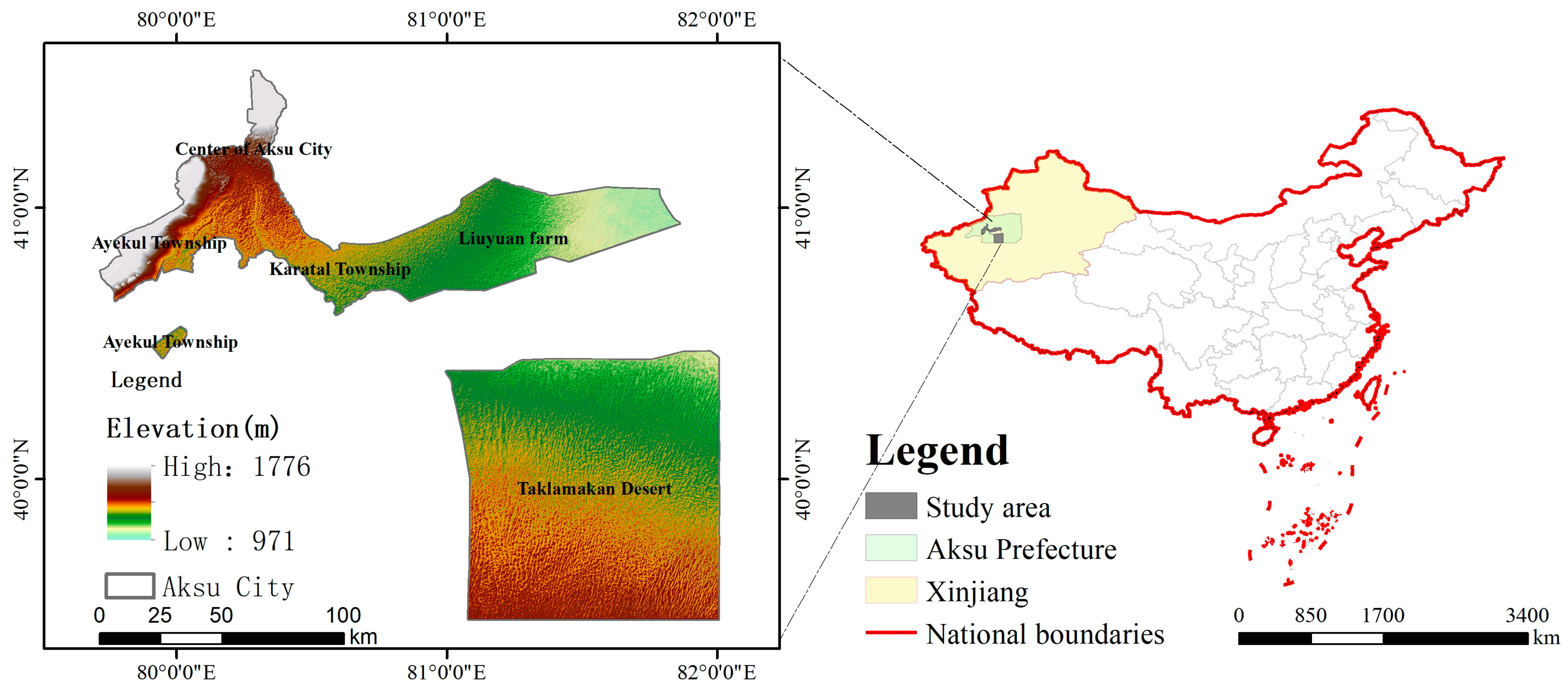
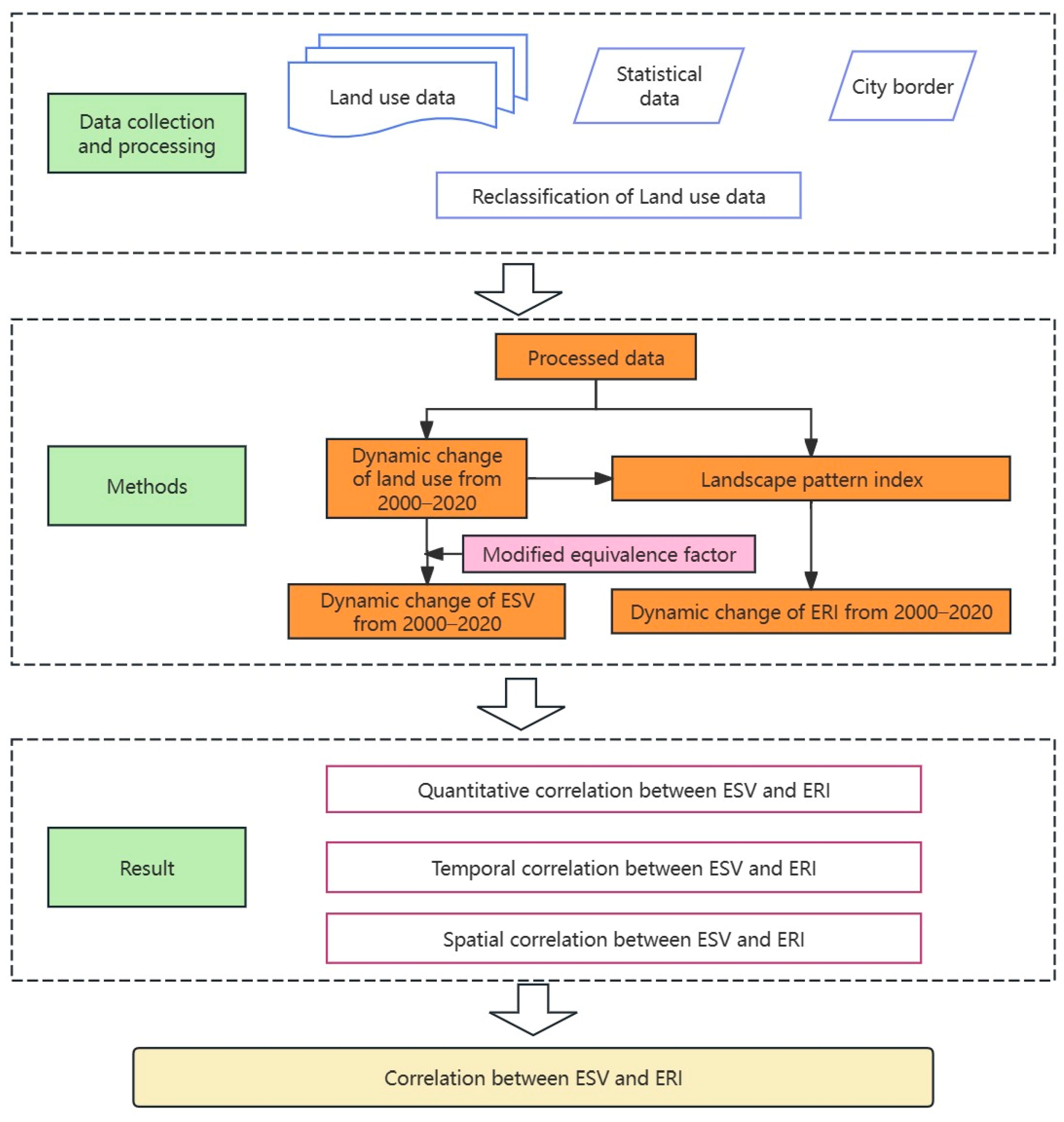
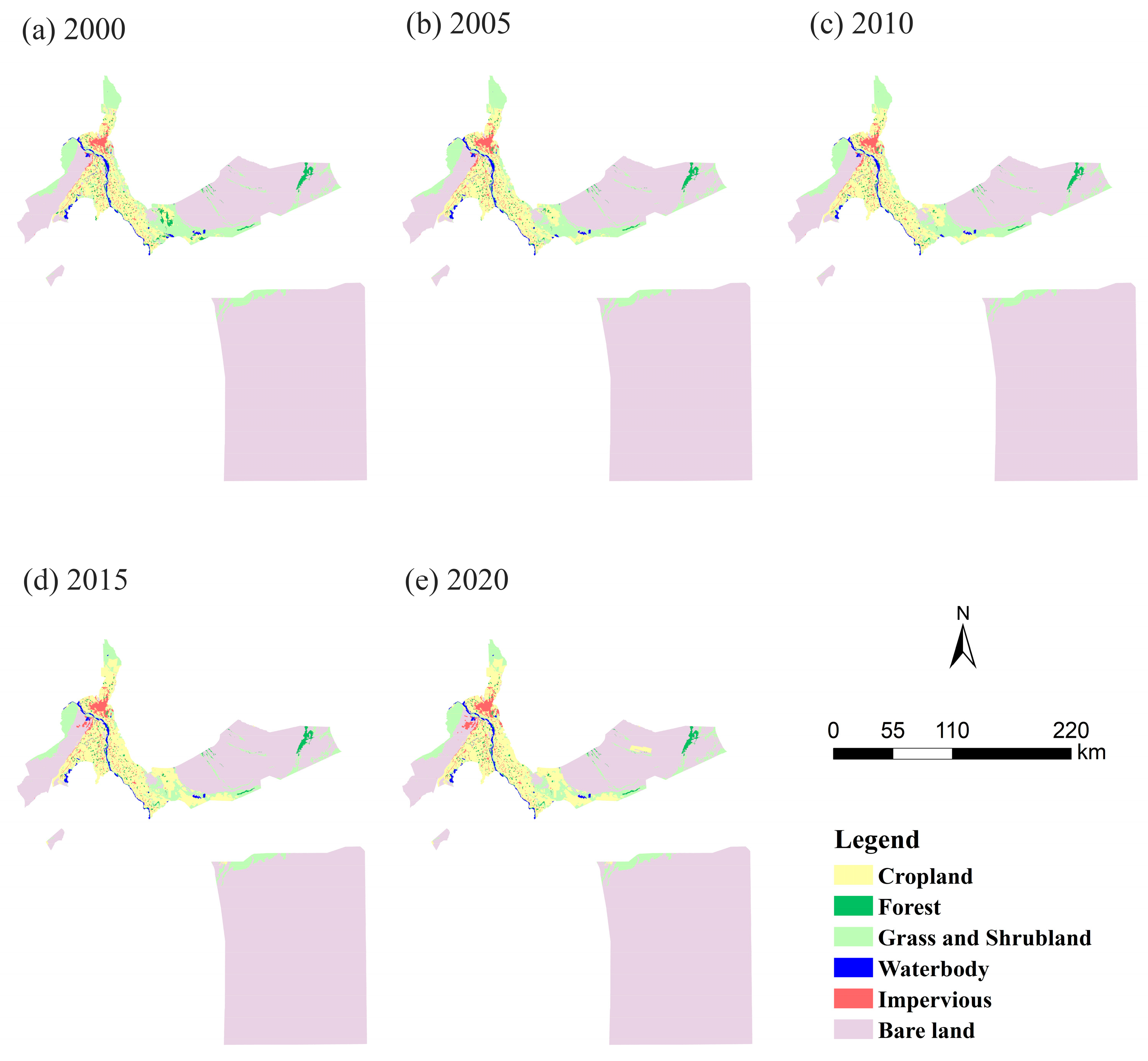
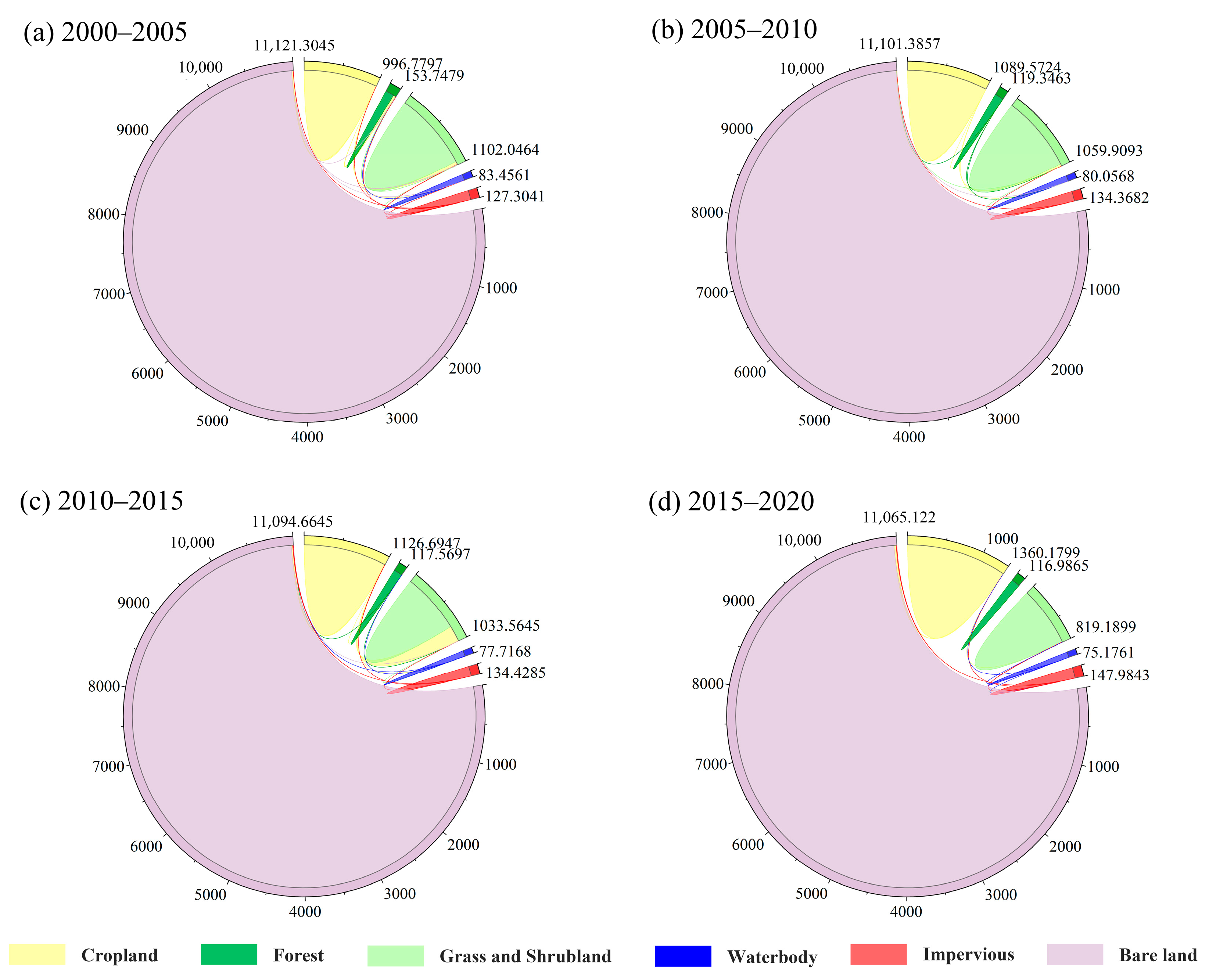
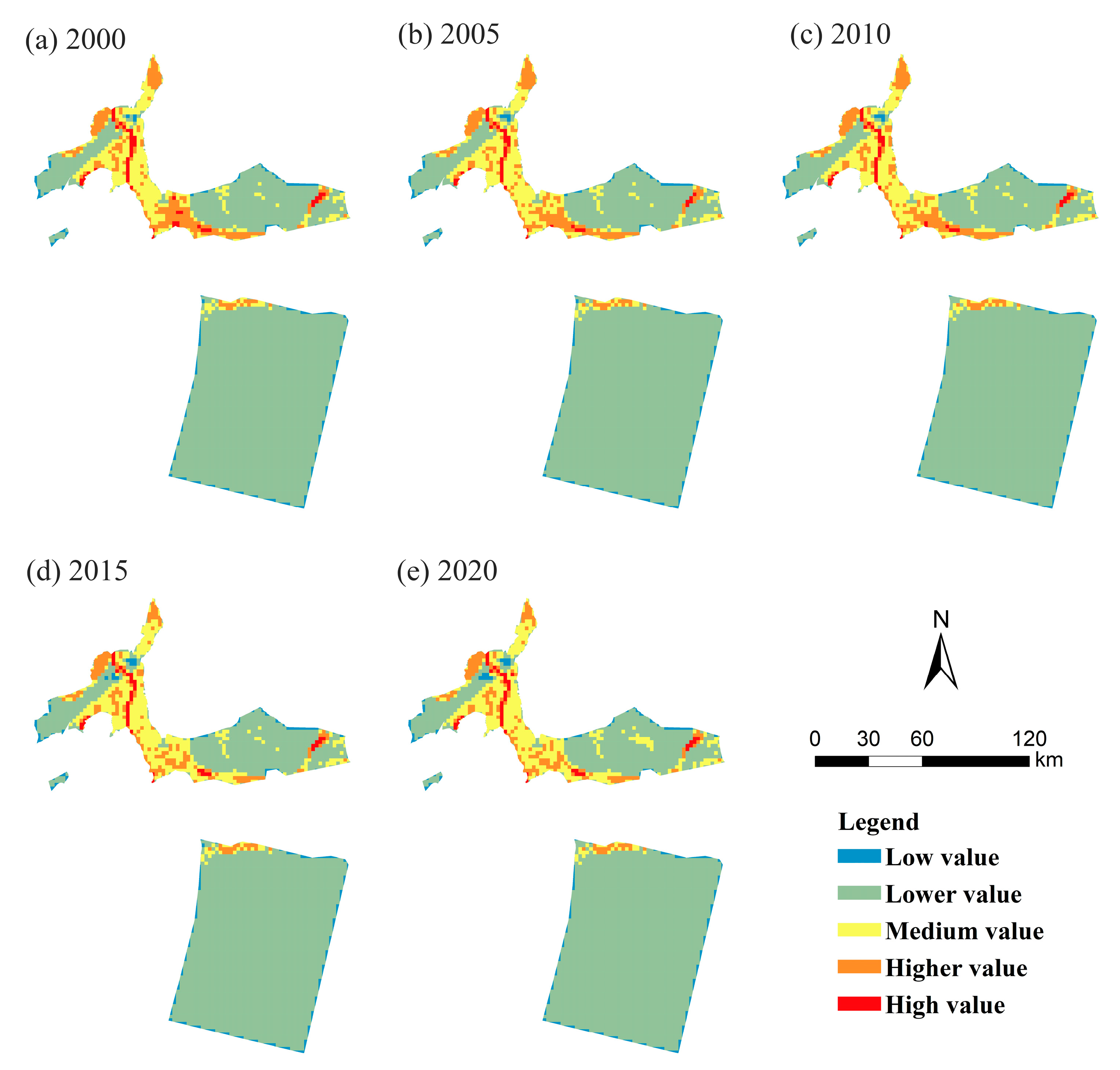


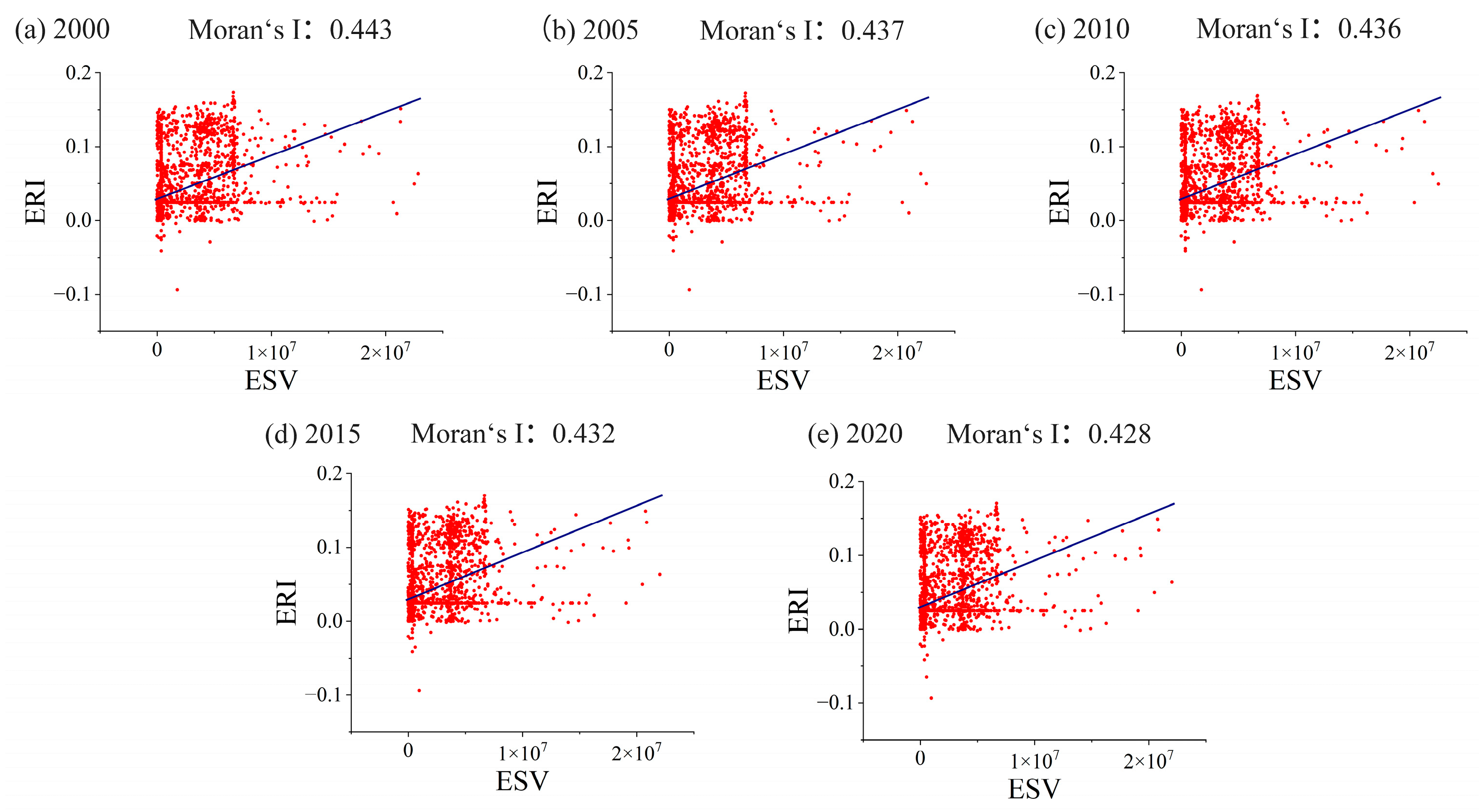

| Data Type | Description | Spatial Resolution | The Source of Data |
|---|---|---|---|
| Underlying data | Land use data | 30 m | https://www.resdc.cn/ |
| Administrative divisions | - | https://www.resdc.cn/ | |
| Statistical data | Grain crop production | - | https://tjj.xinjiang.gov.cn/ |
| Grain crop planted area | - | https://tjj.xinjiang.gov.cn/ | |
| Grain crop unit price | - | https://www.stats.gov.cn/ |
| Ecosystem Services | Land Use Types | ||||||
|---|---|---|---|---|---|---|---|
| Primary Classification | Secondary Classification | C * | F | GS | WB | IP | BL |
| SS | FP | 1537.51 | 351.33 | 324.66 | 607.58 | 0.00 | 6.96 |
| RMP | 340.90 | 3999.43 | 477.72 | 338.58 | 0.00 | 20.87 | |
| WS | 1815.79 | 5797.83 | 264.37 | 6047.99 | 0.00 | 13.91 | |
| RS | GR | 1238.35 | 2654.11 | 1678.97 | 1321.84 | 0.00 | 90.44 |
| CR | 647.01 | 7941.47 | 4438.59 | 2982.25 | 0.00 | 69.57 | |
| PE | 187.84 | 2327.13 | 1465.62 | 4318.00 | 0.00 | 285.24 | |
| HR | 2080.16 | 5196.91 | 3251.26 | 61,964.07 | 0.00 | 166.97 | |
| STS | SC | 723.53 | 3231.55 | 2045.37 | 1502.72 | 0.00 | 104.36 |
| MNC | 215.67 | 246.98 | 157.69 | 115.95 | 0.00 | 6.96 | |
| BD | 236.54 | 2942.83 | 1859.85 | 4837.46 | 0.00 | 97.40 | |
| CS | AC | 104.36 | 2791.55 | 820.93 | 3112.12 | 0.00 | 41.74 |
| Total | 9127.64 | 37,481.11 | 16,785.03 | 87,148.56 | 0.00 | 904.42 | |
| Land Use Type | 2000 | 2005 | 2010 | 2015 | 2020 | |||||
|---|---|---|---|---|---|---|---|---|---|---|
| ESV | % | ESV | % | ESV | % | ESV | % | ESV | % | |
| CL | 9.10 | 17.96 | 9.94 | 20.21 | 10.28 | 21.06 | 12.41 | 26.37 | 12.67 | 26.81 |
| F | 5.76 | 11.37 | 4.47 | 9.09 | 4.41 | 9.03 | 4.38 | 9.31 | 4.38 | 9.28 |
| GS | 18.49 | 36.50 | 17.78 | 36.15 | 17.33 | 35.52 | 13.74 | 29.19 | 13.65 | 28.88 |
| WB | 7.25 | 14.32 | 6.96 | 14.14 | 6.75 | 13.83 | 6.53 | 13.87 | 6.58 | 13.92 |
| IP | 10.06 | 19.86 | 10.04 | 20.41 | 10.03 | 20.56 | 10.00 | 21.26 | 9.97 | 21.11 |
| BL | 9.10 | 17.96 | 9.94 | 20.21 | 10.28 | 21.06 | 12.41 | 26.37 | 12.67 | 26.81 |
| Proportion * | ||||||
|---|---|---|---|---|---|---|
| 2000 | 2005 | 2010 | 2015 | 2020 | 2000–2020 | |
| LR | 0.11 | 0.10 | 0.12 | 0.07 | 0.07 | −0.04% |
| LRR | 79.81 | 79.89 | 79.79 | 79.14 | 78.82 | −0.90 |
| MR | 7.84 | 7.97 | 8.13 | 7.74 | 7.83 | −0.02 |
| HRR | 5.33 | 5.23 | 5.38 | 6.57 | 6.63 | 1.30 |
| HR | 6.90 | 6.81 | 6.58 | 6.47 | 6.64 | −0.26 |
| ERL | 2000–2005 | 2005–2010 | 2010–2015 | 2015–2020 | ||||||||
|---|---|---|---|---|---|---|---|---|---|---|---|---|
| IC | NC | DC | IC | NC | DC | IC | NC | DC | IC | NC | DC | |
| LR | 5 | 204 | 9 | 1 | 207 | 10 | 4 | 198 | 18 | 0 | 210 | 4 |
| LRR | 27 | 2659 | 52 | 12 | 2712 | 13 | 20 | 2661 | 59 | 14 | 2711 | 2 |
| MR | 5 | 193 | 22 | 5 | 209 | 6 | 3 | 184 | 34 | 3 | 214 | 2 |
| HRR | 10 | 179 | 43 | 7 | 200 | 17 | 8 | 124 | 95 | 1 | 241 | 7 |
| HR | 30 | 205 | 63 | 11 | 262 | 34 | 7 | 194 | 97 | 0 | 281 | 16 |
Disclaimer/Publisher’s Note: The statements, opinions and data contained in all publications are solely those of the individual author(s) and contributor(s) and not of MDPI and/or the editor(s). MDPI and/or the editor(s) disclaim responsibility for any injury to people or property resulting from any ideas, methods, instructions or products referred to in the content. |
© 2024 by the authors. Licensee MDPI, Basel, Switzerland. This article is an open access article distributed under the terms and conditions of the Creative Commons Attribution (CC BY) license (https://creativecommons.org/licenses/by/4.0/).
Share and Cite
Li, W.; Ma, Y.; Liu, Y.; Zhang, Y. Study on the Correlation between Ecological Service Value and Ecological Risk of Typical Mountain-Oasis-Desert Ecosystems: A Case Study of Aksu City in Northwest China. Sustainability 2024, 16, 3915. https://doi.org/10.3390/su16103915
Li W, Ma Y, Liu Y, Zhang Y. Study on the Correlation between Ecological Service Value and Ecological Risk of Typical Mountain-Oasis-Desert Ecosystems: A Case Study of Aksu City in Northwest China. Sustainability. 2024; 16(10):3915. https://doi.org/10.3390/su16103915
Chicago/Turabian StyleLi, Weixu, Yanxia Ma, Yongqiang Liu, and Yongfu Zhang. 2024. "Study on the Correlation between Ecological Service Value and Ecological Risk of Typical Mountain-Oasis-Desert Ecosystems: A Case Study of Aksu City in Northwest China" Sustainability 16, no. 10: 3915. https://doi.org/10.3390/su16103915




